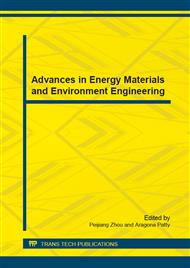p.261
p.265
p.270
p.276
p.281
p.286
p.290
p.294
p.298
Effect of Activated Carbon Fiber Properties on Ca2+ Removal by Capacitive Deionization
Abstract:
Three activated carbon fibers, namely Sample A, B, and C, were used as electrodes for Ca2+ removal by capacitive deionization in this study. The physical properties of ACFs were comprehensively investigated with regard to surface area, pore volume, pore size distribution, specific capacitance, and contact angle. An internal correlation was intended to reveal between the ACF properties and their CDI performance. Pseduo-first-order adsorption kinetics model could successfully depict the Ca2+ removal with different ACF electrodes. Based on the fitting parameters, Sample B with the highest pore volume, specific capacitance, and hydrophilicity exhibited the highest equilibrium electrosorption capacity (9.977 mg-Ca2+/g-ACF). However, Sample A with the highest average pore diameter (2.4 nm) has the highest rate constant (0.074/min). Even though the abundant micropores with diameters less than 2 nm created large specific surface area in Sample C, its uptake of Ca2+ was not as good as that of Sample A.
Info:
Periodical:
Pages:
281-285
Citation:
Online since:
December 2014
Authors:
Price:
Сopyright:
© 2015 Trans Tech Publications Ltd. All Rights Reserved
Share:
Citation:


